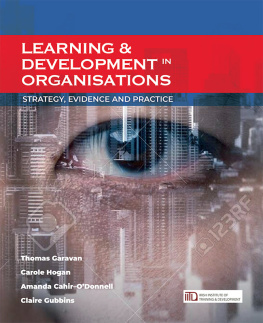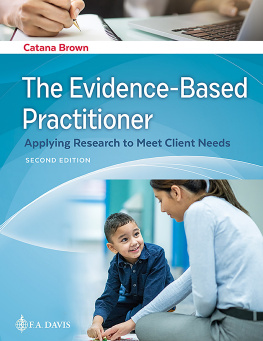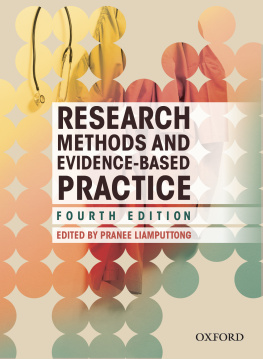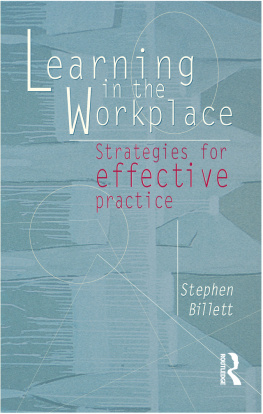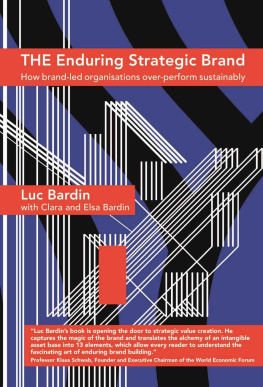LEARNING & DEVELOPMENT IN ORGANISATIONS
Strategy, Evidence and Practice
Thomas Garavan, Carole Hogan, Amanda Cahir-ODonnell & Claire Gubbins

Published by Oak Tree Press, Cork, Ireland
www.oaktreepress.com / www.SuccessStore.com
2020 Thomas Garavan, Carole Hogan, Amanda Cahir-ODonnell, Claire Gubbins
A catalogue record of this book is available from the British Library.
ISBN 978 1 78119 429 4 (hardback)
ISBN 978 1 78119 431 7 (ePub)
ISBN 978 1 78119 432 4 (Kindle)
ISBN 978 1 78119 433 1 (PDF)
Cover image: Preechar Bowonkitwanchai / 123rf.com
Cover design: Kieran OConnor Design
All rights reserved.
No part of this publication may be reproduced or transmitted in any form or by any means, including photocopying, recording or electronically without written permission of the publisher. Such written permission also must be obtained before any part of this publication is stored in a retrieval system of any nature. Requests for permission should be directed to Oak Tree Press, .
FIGURES
TABLES
ABBREVIATIONS
AC abstract conceptualisation
ACT Adaptive Character of Thought model
ADDIE Analysis, Design, Development, Implementation, and Evaluation model
AE active experimentation
AHRD Academy of Human Resource Development
AI artificial intelligence
AMO ability-motivation-opportunity
AO Advanced Operations division (Stryker)
API application programming interface
AR augmented reality
ATI aptitude-treatment interaction
BCR benefit cost ratio
BMT behaviour modelling training
BPO business process outsourcing
BRIC Brazil, Russia, India, and China
CAD computer aided design
CAM computer aided manufacturing
CE concrete experience
CEO chief executive officer
CIPD Chartered Institute of Personnel and Development
CITI Citigroup Inc.
CLO chief learning officer
CMS course management system
COMA Cognitive, Organisational Environment, Motivation, Attitudes model
COOC corporate open online course
CoP community of practice
CPD continuous professional development
CSR corporate social responsibility
CSS cascading style sheet
DOT Development Opportunity Tool (Intel)
EESS economic, environmental and social sustainability
EPSS eLearning performance support system
ERPG ethnocentric, polycentric, regiocentric and geocentric
G2G Googler-to-Googler (Google)
GDM Global Delivery Model (Infosys)
HCN home country national
HPWP high performance work practice
HQ headquarters
HR human resource
HRD human resource development
HRD human resources department
HRM human resources management
HTMLS hypertext mark-up language server-side
ICT information and communication technology
IDP individual development plan
IITD Irish Institute of Training and Development
IMTEE Integrated Model of Training Evaluation and Effectiveness
INGO international nongovernmental organisation
IP intellectual property
ISD instructional system design
IT information technology
J&J Johnson & Johnson
JIT job instruction training
JIT Just-in-time
KBI key business indicator
KPI key performance indicator
KSA knowledge, skills and abilities
L&D learning and development
LCMS learning content management system
LMS learning management system
LTE learning transfer environment
LTSI Learning Transfer System Inventory
M&A mergers and acquisitions
M&S Marks & Spencer
MNC multinational corporation
MOOC massive open online course
OHP overhead projector (slides)
OWL Web ontology language
PCN parent country national
PDF portable document format
Q&A question and answer
RBV resource-based view
RO reflective observation
ROE return on expectation
ROI return on investment
SDL self-directed learning
SEED School Earth Education
SHRD strategic human resource development
SME subject matter expert
SOP standard operating procedure(s)
SPARQL Semantic protocol and RDF query language
SPOC small private online course
SSW social semantic web
STOP Safety Training Observation Program (DuPont)
TCN third country national
TOOT Time out of Time
TWI Training within Industry
UN United Nations
US United States (of America)
USA United States of America
VARK Visual-Auditory-Read-Kinaesthetic model
VLE virtual learning environment
VLS virtual learning system
VR virtual reality
XML extensive mark-up language
FOREWORD
Business leaders know that todays fast-accelerating changes in technology, longevity, work practices, and business models offer both challenges and opportunities. While some jobs are disappearing due to advances in technology, many more are being transformed and thus creating the need for continuous, lifelong development. In response to this evolving landscape, Learning and Development (L&D) professionals are prioritising strategic imperatives such as transitioning to the future of work, the redesign of work and jobs, and reskilling the workforce to support the ongoing evolution of organisations.
It is imperative that L&D professionals shift their focus from the dominant paradigms that the profession has relied on for the past 50 years and examine more contemporary ways in which to improve their practice as professionals. The reality is that the future has started. We need to invest in breakthrough thinking and innovation to sustain success and face up to the challenges of the new business, customer and market paradigms. Encouraging an organisations workforce to learn and to change and adapt to the needs of the organisation is now more important than ever in order to respond to the requirements of the workplace of the future. L&D professionals have a major role to play in helping organisations to ensure that they have a workforce that is capable of adapting to those changing requirements.
Accordingly, as the leading professional body for L&D professionals in Ireland, the Irish Institute of Training and Development (IITD) commissioned LEARNING & DEVELOPMENT in ORGANISATIONS: STRATEGY, EVIDENCE and PRACTICE to reflect the changing landscape of L&D. Our intent in commissioning this book was to support L&D professionals by sharing the most up-to-date thinking to assist them in the development of capability throughout their organisations. The book aims to develop L&D professionals so that they deliver impactful learning interventions that develop staff by thinking innovatively about how work is organised and ensuring the best alignment of people and technology with the right opportunities within their organisations. It considers both formal and informal learning and looks at the contribution of the L&D function to organisational and financial performance. Reflecting the latest thinking in the field of L&D, it provides a theoretically-sound text written with the user in mind, whether that user is a practitioner or a student. Included in each chapter, to help the reader to relate the text to practical application, are case studies that show the theory in action. Critically, the book looks at the future of L&D and the competencies that are required into the future as well as examining ethical considerations in the field of L&D.
Next page
